Service Marketing Report: Restaurant Service Failure Analysis
VerifiedAdded on 2023/06/03
|9
|2094
|243
Report
AI Summary
This report presents a comprehensive analysis of a service failure incident experienced at a restaurant. It begins by detailing a negative service encounter, highlighting issues such as inadequate staffing, unprofessional staff behavior, and menu discrepancies. The report then applies theoretical frameworks, particularly the SERVQUAL model, to evaluate the service quality dimensions and identify gaps in customer expectations. An instrumental type of complaint is identified. The root causes of the failure are examined, focusing on management's responsibility for employee shortages and lack of professionalism. Furthermore, the report proposes service recovery strategies, including compensatory and restoration approaches, to address customer dissatisfaction. Recommendations are provided to enhance customer retention and loyalty, emphasizing the importance of learning from service failures, staying connected with customers, and improving employee skills. The report concludes by underscoring the significance of adopting effective practices to deliver excellent customer service.
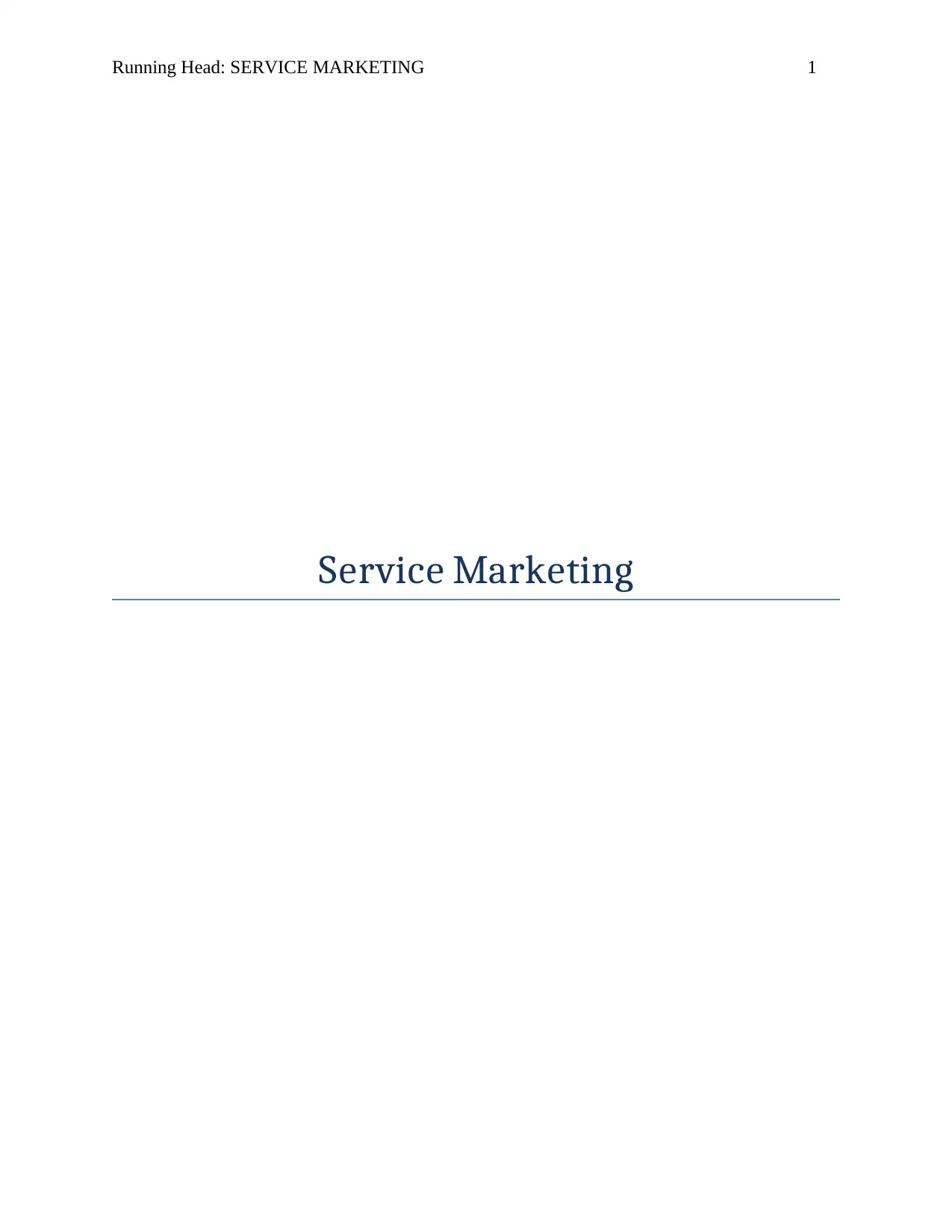
Running Head: SERVICE MARKETING 1
Service Marketing
Service Marketing
Paraphrase This Document
Need a fresh take? Get an instant paraphrase of this document with our AI Paraphraser
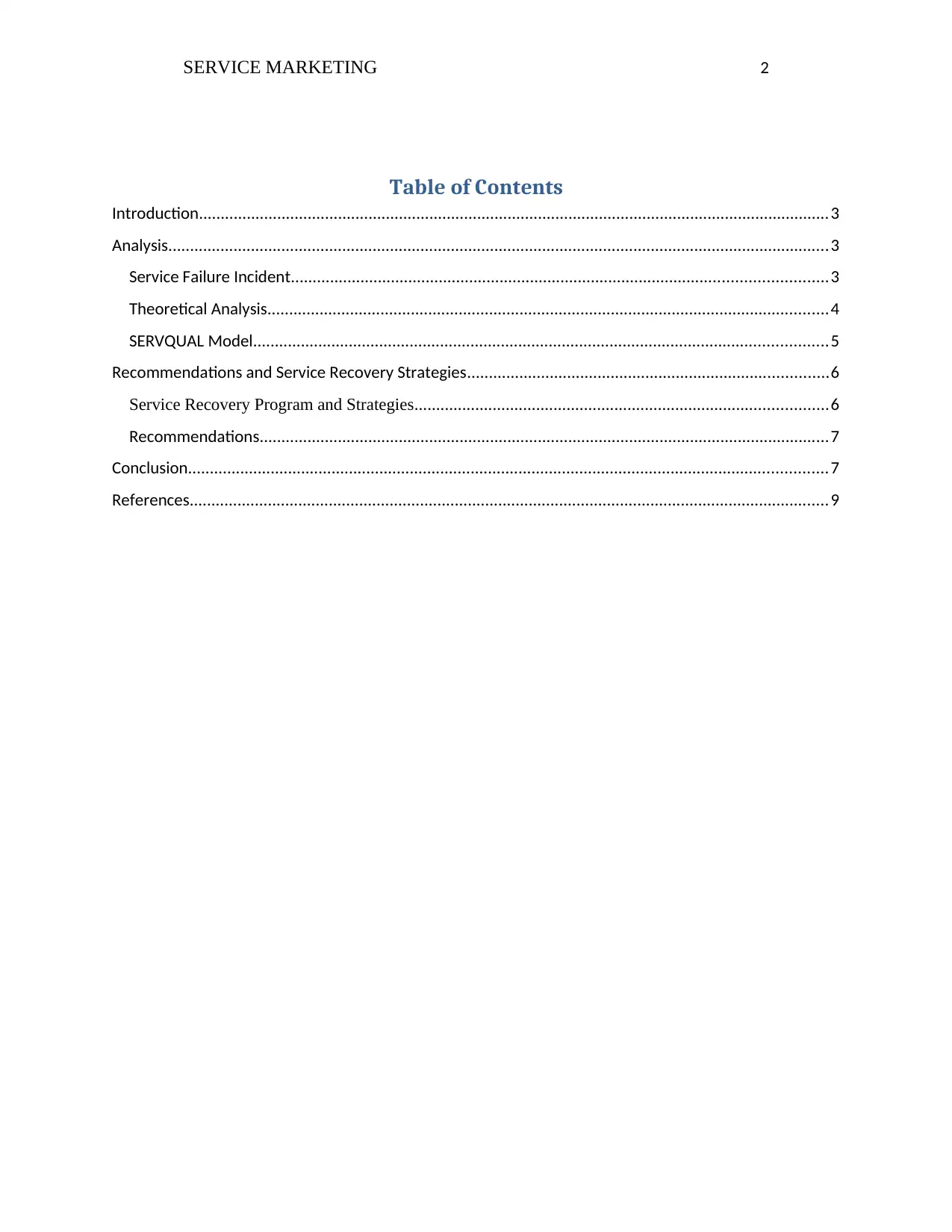
SERVICE MARKETING 2
Table of Contents
Introduction.................................................................................................................................................3
Analysis........................................................................................................................................................3
Service Failure Incident...........................................................................................................................3
Theoretical Analysis.................................................................................................................................4
SERVQUAL Model....................................................................................................................................5
Recommendations and Service Recovery Strategies...................................................................................6
Service Recovery Program and Strategies...............................................................................................6
Recommendations...................................................................................................................................7
Conclusion...................................................................................................................................................7
References...................................................................................................................................................9
Table of Contents
Introduction.................................................................................................................................................3
Analysis........................................................................................................................................................3
Service Failure Incident...........................................................................................................................3
Theoretical Analysis.................................................................................................................................4
SERVQUAL Model....................................................................................................................................5
Recommendations and Service Recovery Strategies...................................................................................6
Service Recovery Program and Strategies...............................................................................................6
Recommendations...................................................................................................................................7
Conclusion...................................................................................................................................................7
References...................................................................................................................................................9
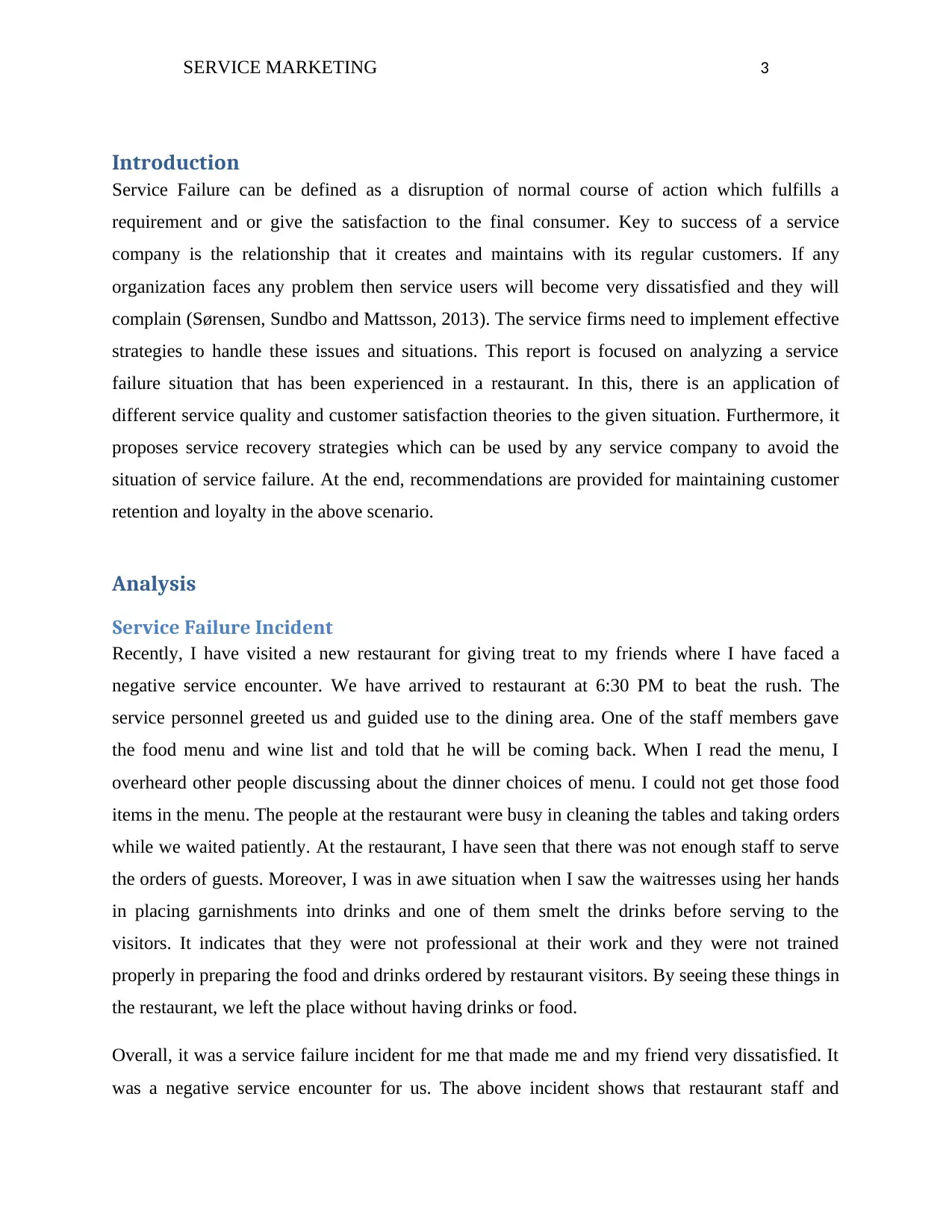
SERVICE MARKETING 3
Introduction
Service Failure can be defined as a disruption of normal course of action which fulfills a
requirement and or give the satisfaction to the final consumer. Key to success of a service
company is the relationship that it creates and maintains with its regular customers. If any
organization faces any problem then service users will become very dissatisfied and they will
complain (Sørensen, Sundbo and Mattsson, 2013). The service firms need to implement effective
strategies to handle these issues and situations. This report is focused on analyzing a service
failure situation that has been experienced in a restaurant. In this, there is an application of
different service quality and customer satisfaction theories to the given situation. Furthermore, it
proposes service recovery strategies which can be used by any service company to avoid the
situation of service failure. At the end, recommendations are provided for maintaining customer
retention and loyalty in the above scenario.
Analysis
Service Failure Incident
Recently, I have visited a new restaurant for giving treat to my friends where I have faced a
negative service encounter. We have arrived to restaurant at 6:30 PM to beat the rush. The
service personnel greeted us and guided use to the dining area. One of the staff members gave
the food menu and wine list and told that he will be coming back. When I read the menu, I
overheard other people discussing about the dinner choices of menu. I could not get those food
items in the menu. The people at the restaurant were busy in cleaning the tables and taking orders
while we waited patiently. At the restaurant, I have seen that there was not enough staff to serve
the orders of guests. Moreover, I was in awe situation when I saw the waitresses using her hands
in placing garnishments into drinks and one of them smelt the drinks before serving to the
visitors. It indicates that they were not professional at their work and they were not trained
properly in preparing the food and drinks ordered by restaurant visitors. By seeing these things in
the restaurant, we left the place without having drinks or food.
Overall, it was a service failure incident for me that made me and my friend very dissatisfied. It
was a negative service encounter for us. The above incident shows that restaurant staff and
Introduction
Service Failure can be defined as a disruption of normal course of action which fulfills a
requirement and or give the satisfaction to the final consumer. Key to success of a service
company is the relationship that it creates and maintains with its regular customers. If any
organization faces any problem then service users will become very dissatisfied and they will
complain (Sørensen, Sundbo and Mattsson, 2013). The service firms need to implement effective
strategies to handle these issues and situations. This report is focused on analyzing a service
failure situation that has been experienced in a restaurant. In this, there is an application of
different service quality and customer satisfaction theories to the given situation. Furthermore, it
proposes service recovery strategies which can be used by any service company to avoid the
situation of service failure. At the end, recommendations are provided for maintaining customer
retention and loyalty in the above scenario.
Analysis
Service Failure Incident
Recently, I have visited a new restaurant for giving treat to my friends where I have faced a
negative service encounter. We have arrived to restaurant at 6:30 PM to beat the rush. The
service personnel greeted us and guided use to the dining area. One of the staff members gave
the food menu and wine list and told that he will be coming back. When I read the menu, I
overheard other people discussing about the dinner choices of menu. I could not get those food
items in the menu. The people at the restaurant were busy in cleaning the tables and taking orders
while we waited patiently. At the restaurant, I have seen that there was not enough staff to serve
the orders of guests. Moreover, I was in awe situation when I saw the waitresses using her hands
in placing garnishments into drinks and one of them smelt the drinks before serving to the
visitors. It indicates that they were not professional at their work and they were not trained
properly in preparing the food and drinks ordered by restaurant visitors. By seeing these things in
the restaurant, we left the place without having drinks or food.
Overall, it was a service failure incident for me that made me and my friend very dissatisfied. It
was a negative service encounter for us. The above incident shows that restaurant staff and
⊘ This is a preview!⊘
Do you want full access?
Subscribe today to unlock all pages.

Trusted by 1+ million students worldwide
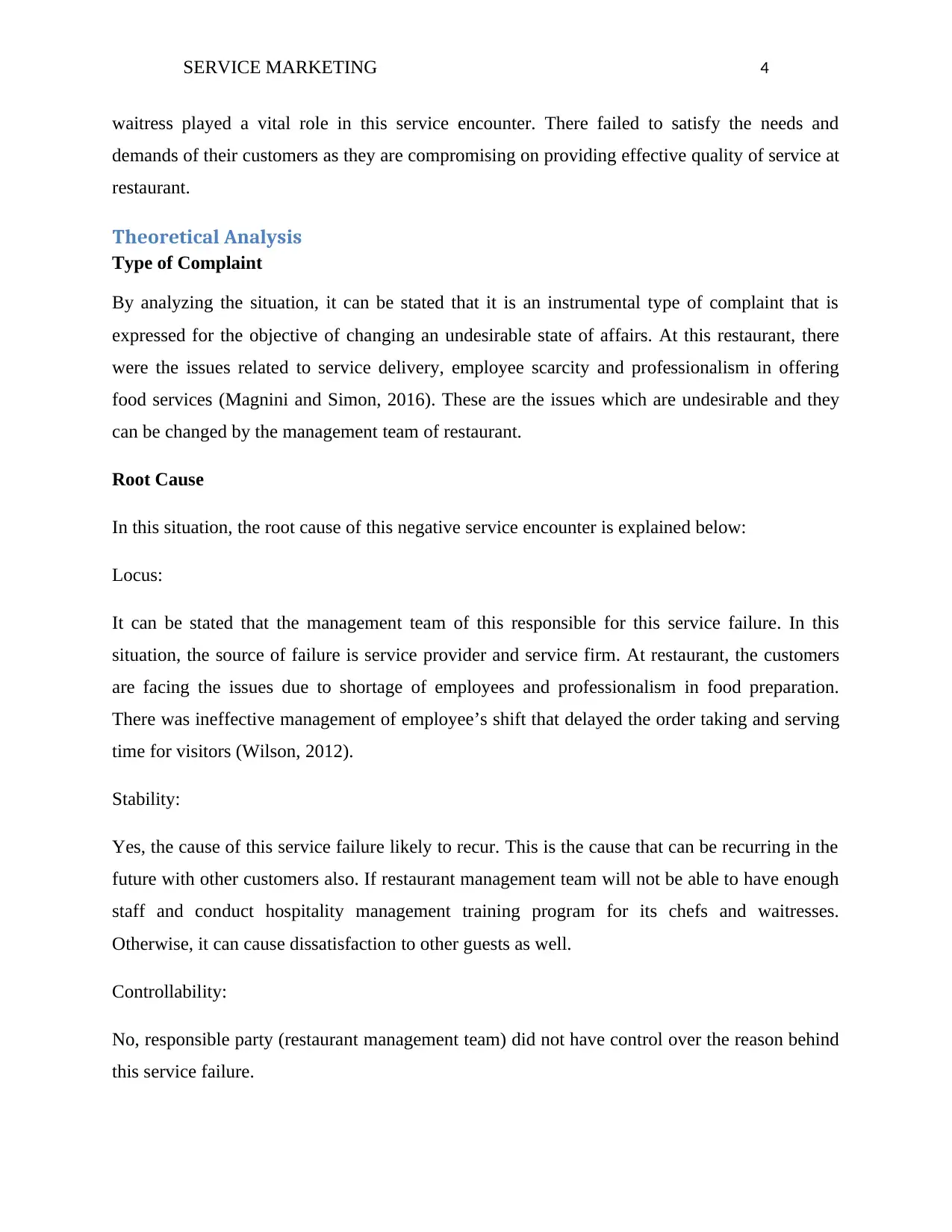
SERVICE MARKETING 4
waitress played a vital role in this service encounter. There failed to satisfy the needs and
demands of their customers as they are compromising on providing effective quality of service at
restaurant.
Theoretical Analysis
Type of Complaint
By analyzing the situation, it can be stated that it is an instrumental type of complaint that is
expressed for the objective of changing an undesirable state of affairs. At this restaurant, there
were the issues related to service delivery, employee scarcity and professionalism in offering
food services (Magnini and Simon, 2016). These are the issues which are undesirable and they
can be changed by the management team of restaurant.
Root Cause
In this situation, the root cause of this negative service encounter is explained below:
Locus:
It can be stated that the management team of this responsible for this service failure. In this
situation, the source of failure is service provider and service firm. At restaurant, the customers
are facing the issues due to shortage of employees and professionalism in food preparation.
There was ineffective management of employee’s shift that delayed the order taking and serving
time for visitors (Wilson, 2012).
Stability:
Yes, the cause of this service failure likely to recur. This is the cause that can be recurring in the
future with other customers also. If restaurant management team will not be able to have enough
staff and conduct hospitality management training program for its chefs and waitresses.
Otherwise, it can cause dissatisfaction to other guests as well.
Controllability:
No, responsible party (restaurant management team) did not have control over the reason behind
this service failure.
waitress played a vital role in this service encounter. There failed to satisfy the needs and
demands of their customers as they are compromising on providing effective quality of service at
restaurant.
Theoretical Analysis
Type of Complaint
By analyzing the situation, it can be stated that it is an instrumental type of complaint that is
expressed for the objective of changing an undesirable state of affairs. At this restaurant, there
were the issues related to service delivery, employee scarcity and professionalism in offering
food services (Magnini and Simon, 2016). These are the issues which are undesirable and they
can be changed by the management team of restaurant.
Root Cause
In this situation, the root cause of this negative service encounter is explained below:
Locus:
It can be stated that the management team of this responsible for this service failure. In this
situation, the source of failure is service provider and service firm. At restaurant, the customers
are facing the issues due to shortage of employees and professionalism in food preparation.
There was ineffective management of employee’s shift that delayed the order taking and serving
time for visitors (Wilson, 2012).
Stability:
Yes, the cause of this service failure likely to recur. This is the cause that can be recurring in the
future with other customers also. If restaurant management team will not be able to have enough
staff and conduct hospitality management training program for its chefs and waitresses.
Otherwise, it can cause dissatisfaction to other guests as well.
Controllability:
No, responsible party (restaurant management team) did not have control over the reason behind
this service failure.
Paraphrase This Document
Need a fresh take? Get an instant paraphrase of this document with our AI Paraphraser
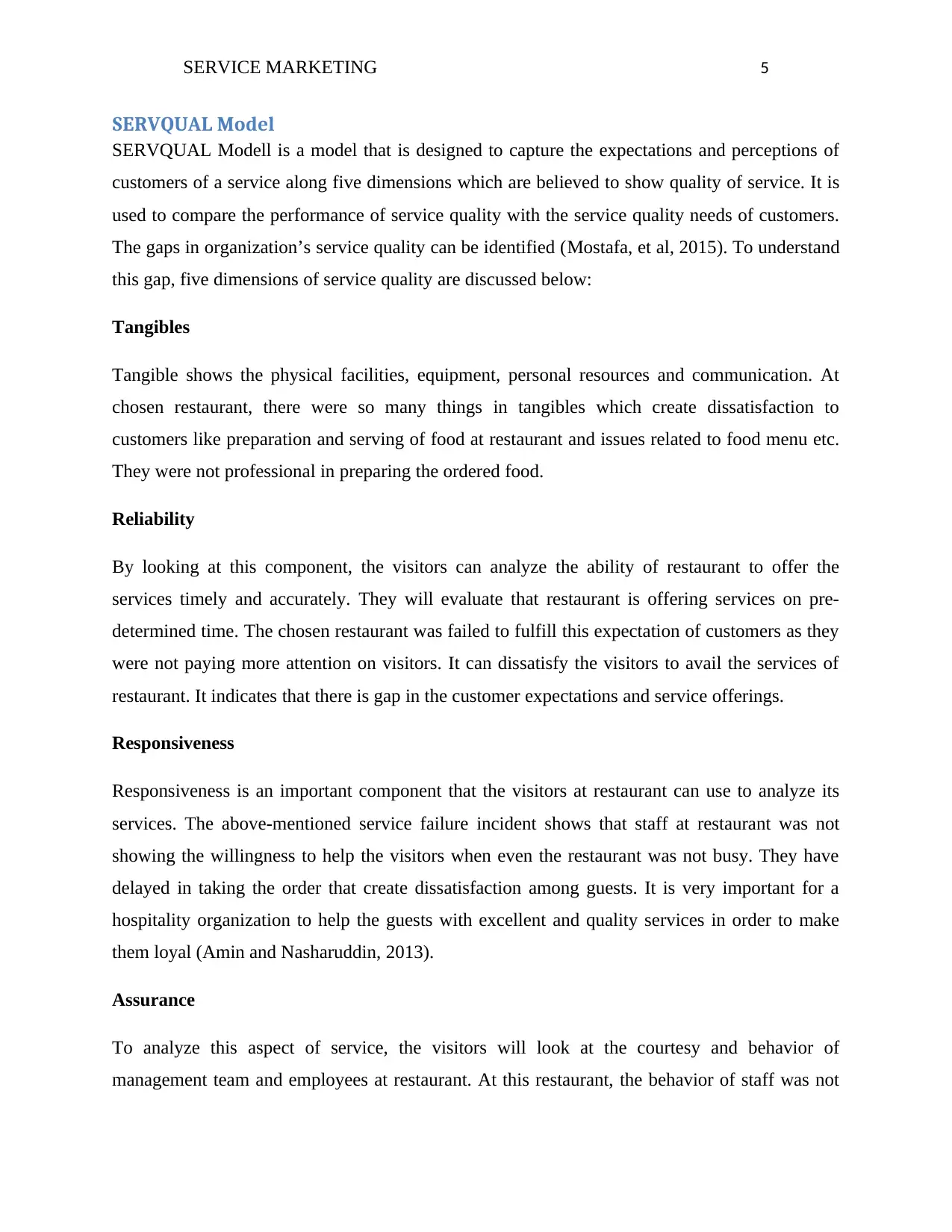
SERVICE MARKETING 5
SERVQUAL Model
SERVQUAL Modell is a model that is designed to capture the expectations and perceptions of
customers of a service along five dimensions which are believed to show quality of service. It is
used to compare the performance of service quality with the service quality needs of customers.
The gaps in organization’s service quality can be identified (Mostafa, et al, 2015). To understand
this gap, five dimensions of service quality are discussed below:
Tangibles
Tangible shows the physical facilities, equipment, personal resources and communication. At
chosen restaurant, there were so many things in tangibles which create dissatisfaction to
customers like preparation and serving of food at restaurant and issues related to food menu etc.
They were not professional in preparing the ordered food.
Reliability
By looking at this component, the visitors can analyze the ability of restaurant to offer the
services timely and accurately. They will evaluate that restaurant is offering services on pre-
determined time. The chosen restaurant was failed to fulfill this expectation of customers as they
were not paying more attention on visitors. It can dissatisfy the visitors to avail the services of
restaurant. It indicates that there is gap in the customer expectations and service offerings.
Responsiveness
Responsiveness is an important component that the visitors at restaurant can use to analyze its
services. The above-mentioned service failure incident shows that staff at restaurant was not
showing the willingness to help the visitors when even the restaurant was not busy. They have
delayed in taking the order that create dissatisfaction among guests. It is very important for a
hospitality organization to help the guests with excellent and quality services in order to make
them loyal (Amin and Nasharuddin, 2013).
Assurance
To analyze this aspect of service, the visitors will look at the courtesy and behavior of
management team and employees at restaurant. At this restaurant, the behavior of staff was not
SERVQUAL Model
SERVQUAL Modell is a model that is designed to capture the expectations and perceptions of
customers of a service along five dimensions which are believed to show quality of service. It is
used to compare the performance of service quality with the service quality needs of customers.
The gaps in organization’s service quality can be identified (Mostafa, et al, 2015). To understand
this gap, five dimensions of service quality are discussed below:
Tangibles
Tangible shows the physical facilities, equipment, personal resources and communication. At
chosen restaurant, there were so many things in tangibles which create dissatisfaction to
customers like preparation and serving of food at restaurant and issues related to food menu etc.
They were not professional in preparing the ordered food.
Reliability
By looking at this component, the visitors can analyze the ability of restaurant to offer the
services timely and accurately. They will evaluate that restaurant is offering services on pre-
determined time. The chosen restaurant was failed to fulfill this expectation of customers as they
were not paying more attention on visitors. It can dissatisfy the visitors to avail the services of
restaurant. It indicates that there is gap in the customer expectations and service offerings.
Responsiveness
Responsiveness is an important component that the visitors at restaurant can use to analyze its
services. The above-mentioned service failure incident shows that staff at restaurant was not
showing the willingness to help the visitors when even the restaurant was not busy. They have
delayed in taking the order that create dissatisfaction among guests. It is very important for a
hospitality organization to help the guests with excellent and quality services in order to make
them loyal (Amin and Nasharuddin, 2013).
Assurance
To analyze this aspect of service, the visitors will look at the courtesy and behavior of
management team and employees at restaurant. At this restaurant, the behavior of staff was not
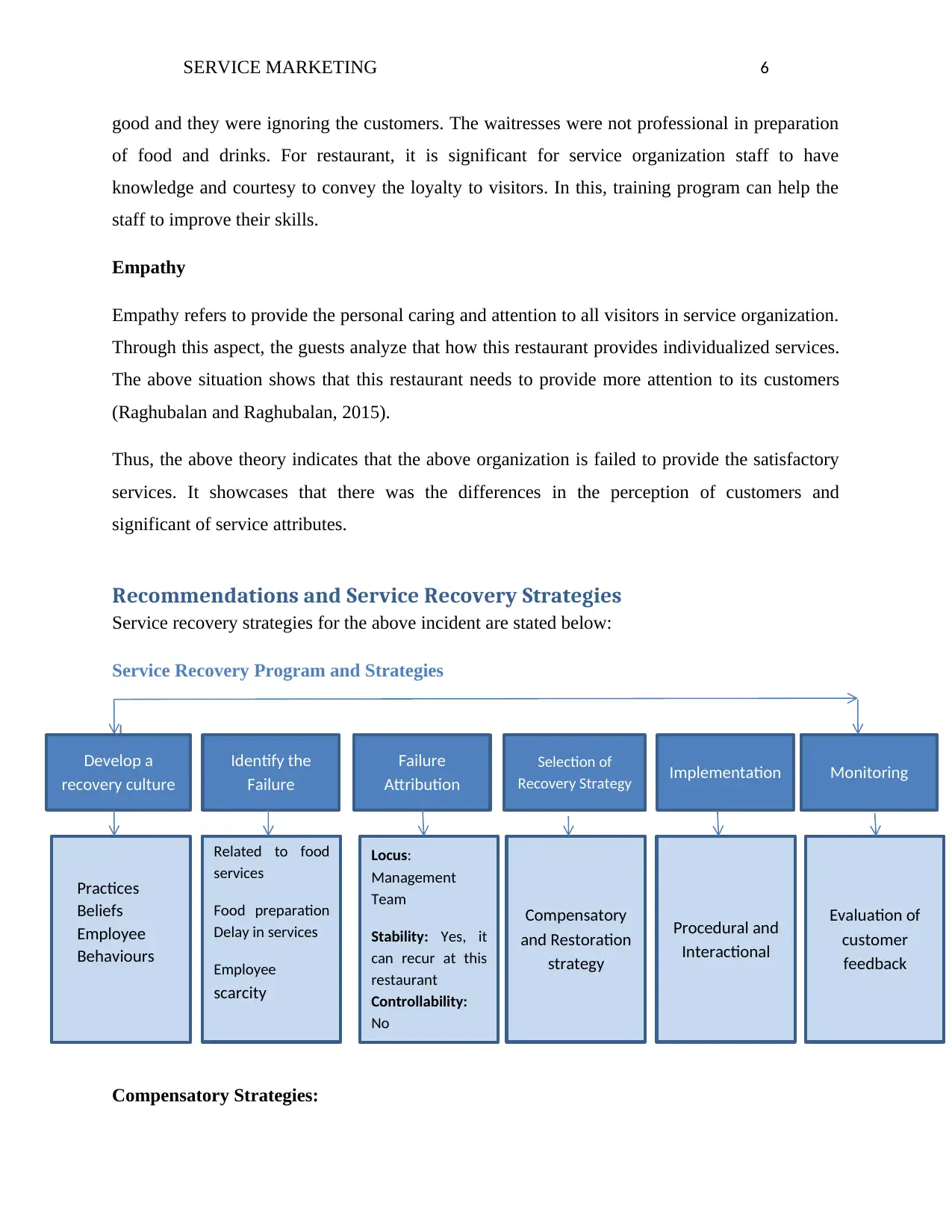
SERVICE MARKETING 6
good and they were ignoring the customers. The waitresses were not professional in preparation
of food and drinks. For restaurant, it is significant for service organization staff to have
knowledge and courtesy to convey the loyalty to visitors. In this, training program can help the
staff to improve their skills.
Empathy
Empathy refers to provide the personal caring and attention to all visitors in service organization.
Through this aspect, the guests analyze that how this restaurant provides individualized services.
The above situation shows that this restaurant needs to provide more attention to its customers
(Raghubalan and Raghubalan, 2015).
Thus, the above theory indicates that the above organization is failed to provide the satisfactory
services. It showcases that there was the differences in the perception of customers and
significant of service attributes.
Recommendations and Service Recovery Strategies
Service recovery strategies for the above incident are stated below:
Service Recovery Program and Strategies
Compensatory Strategies:
Develop a
recovery culture
Identify the
Failure
Failure
Attribution
Selection of
Recovery Strategy Implementation Monitoring
Practices
Beliefs
Employee
Behaviours
Related to food
services
Food preparation
Delay in services
Employee
scarcity
Locus:
Management
Team
Stability: Yes, it
can recur at this
restaurant
Controllability:
No
Compensatory
and Restoration
strategy
Procedural and
Interactional
Evaluation of
customer
feedback
good and they were ignoring the customers. The waitresses were not professional in preparation
of food and drinks. For restaurant, it is significant for service organization staff to have
knowledge and courtesy to convey the loyalty to visitors. In this, training program can help the
staff to improve their skills.
Empathy
Empathy refers to provide the personal caring and attention to all visitors in service organization.
Through this aspect, the guests analyze that how this restaurant provides individualized services.
The above situation shows that this restaurant needs to provide more attention to its customers
(Raghubalan and Raghubalan, 2015).
Thus, the above theory indicates that the above organization is failed to provide the satisfactory
services. It showcases that there was the differences in the perception of customers and
significant of service attributes.
Recommendations and Service Recovery Strategies
Service recovery strategies for the above incident are stated below:
Service Recovery Program and Strategies
Compensatory Strategies:
Develop a
recovery culture
Identify the
Failure
Failure
Attribution
Selection of
Recovery Strategy Implementation Monitoring
Practices
Beliefs
Employee
Behaviours
Related to food
services
Food preparation
Delay in services
Employee
scarcity
Locus:
Management
Team
Stability: Yes, it
can recur at this
restaurant
Controllability:
No
Compensatory
and Restoration
strategy
Procedural and
Interactional
Evaluation of
customer
feedback
⊘ This is a preview!⊘
Do you want full access?
Subscribe today to unlock all pages.

Trusted by 1+ million students worldwide
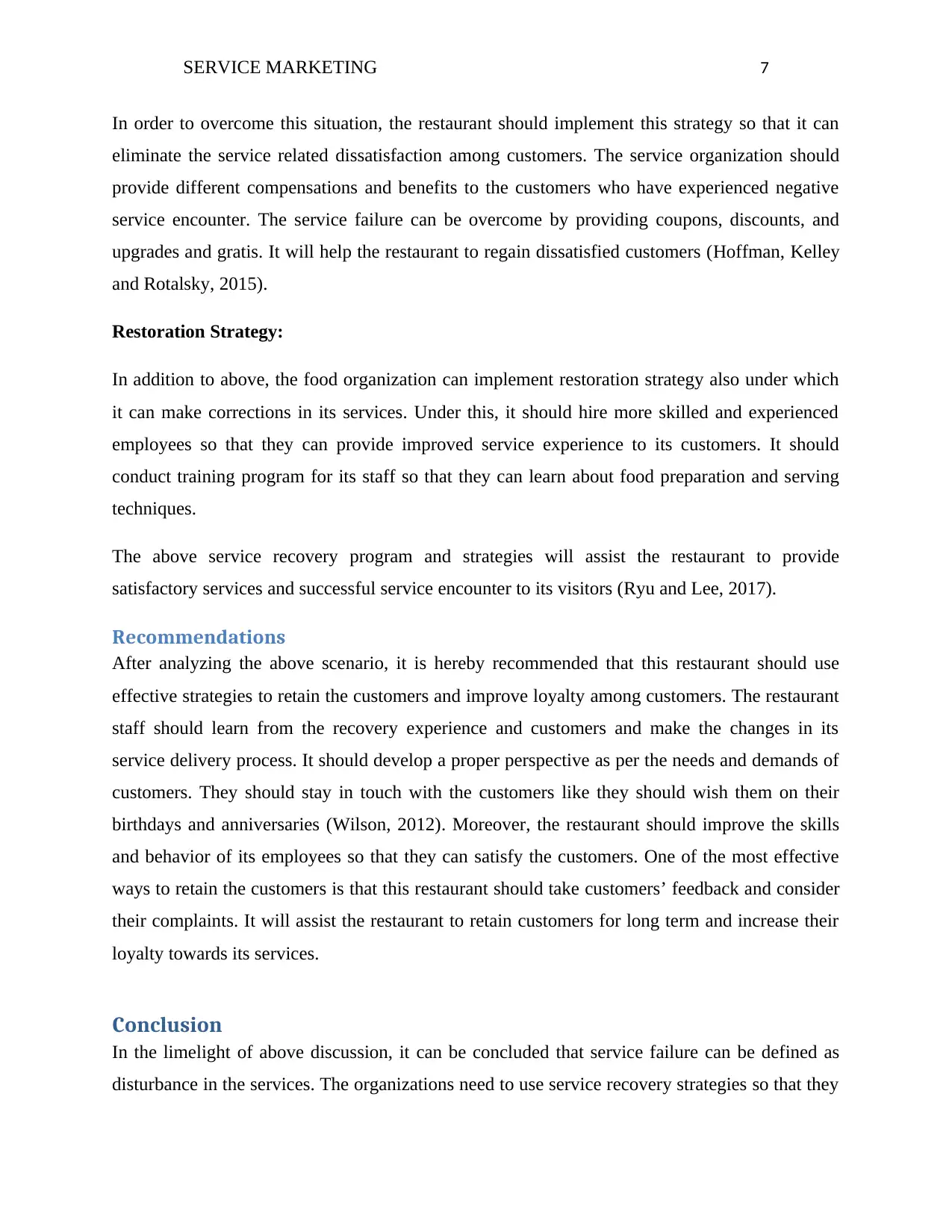
SERVICE MARKETING 7
In order to overcome this situation, the restaurant should implement this strategy so that it can
eliminate the service related dissatisfaction among customers. The service organization should
provide different compensations and benefits to the customers who have experienced negative
service encounter. The service failure can be overcome by providing coupons, discounts, and
upgrades and gratis. It will help the restaurant to regain dissatisfied customers (Hoffman, Kelley
and Rotalsky, 2015).
Restoration Strategy:
In addition to above, the food organization can implement restoration strategy also under which
it can make corrections in its services. Under this, it should hire more skilled and experienced
employees so that they can provide improved service experience to its customers. It should
conduct training program for its staff so that they can learn about food preparation and serving
techniques.
The above service recovery program and strategies will assist the restaurant to provide
satisfactory services and successful service encounter to its visitors (Ryu and Lee, 2017).
Recommendations
After analyzing the above scenario, it is hereby recommended that this restaurant should use
effective strategies to retain the customers and improve loyalty among customers. The restaurant
staff should learn from the recovery experience and customers and make the changes in its
service delivery process. It should develop a proper perspective as per the needs and demands of
customers. They should stay in touch with the customers like they should wish them on their
birthdays and anniversaries (Wilson, 2012). Moreover, the restaurant should improve the skills
and behavior of its employees so that they can satisfy the customers. One of the most effective
ways to retain the customers is that this restaurant should take customers’ feedback and consider
their complaints. It will assist the restaurant to retain customers for long term and increase their
loyalty towards its services.
Conclusion
In the limelight of above discussion, it can be concluded that service failure can be defined as
disturbance in the services. The organizations need to use service recovery strategies so that they
In order to overcome this situation, the restaurant should implement this strategy so that it can
eliminate the service related dissatisfaction among customers. The service organization should
provide different compensations and benefits to the customers who have experienced negative
service encounter. The service failure can be overcome by providing coupons, discounts, and
upgrades and gratis. It will help the restaurant to regain dissatisfied customers (Hoffman, Kelley
and Rotalsky, 2015).
Restoration Strategy:
In addition to above, the food organization can implement restoration strategy also under which
it can make corrections in its services. Under this, it should hire more skilled and experienced
employees so that they can provide improved service experience to its customers. It should
conduct training program for its staff so that they can learn about food preparation and serving
techniques.
The above service recovery program and strategies will assist the restaurant to provide
satisfactory services and successful service encounter to its visitors (Ryu and Lee, 2017).
Recommendations
After analyzing the above scenario, it is hereby recommended that this restaurant should use
effective strategies to retain the customers and improve loyalty among customers. The restaurant
staff should learn from the recovery experience and customers and make the changes in its
service delivery process. It should develop a proper perspective as per the needs and demands of
customers. They should stay in touch with the customers like they should wish them on their
birthdays and anniversaries (Wilson, 2012). Moreover, the restaurant should improve the skills
and behavior of its employees so that they can satisfy the customers. One of the most effective
ways to retain the customers is that this restaurant should take customers’ feedback and consider
their complaints. It will assist the restaurant to retain customers for long term and increase their
loyalty towards its services.
Conclusion
In the limelight of above discussion, it can be concluded that service failure can be defined as
disturbance in the services. The organizations need to use service recovery strategies so that they
Paraphrase This Document
Need a fresh take? Get an instant paraphrase of this document with our AI Paraphraser
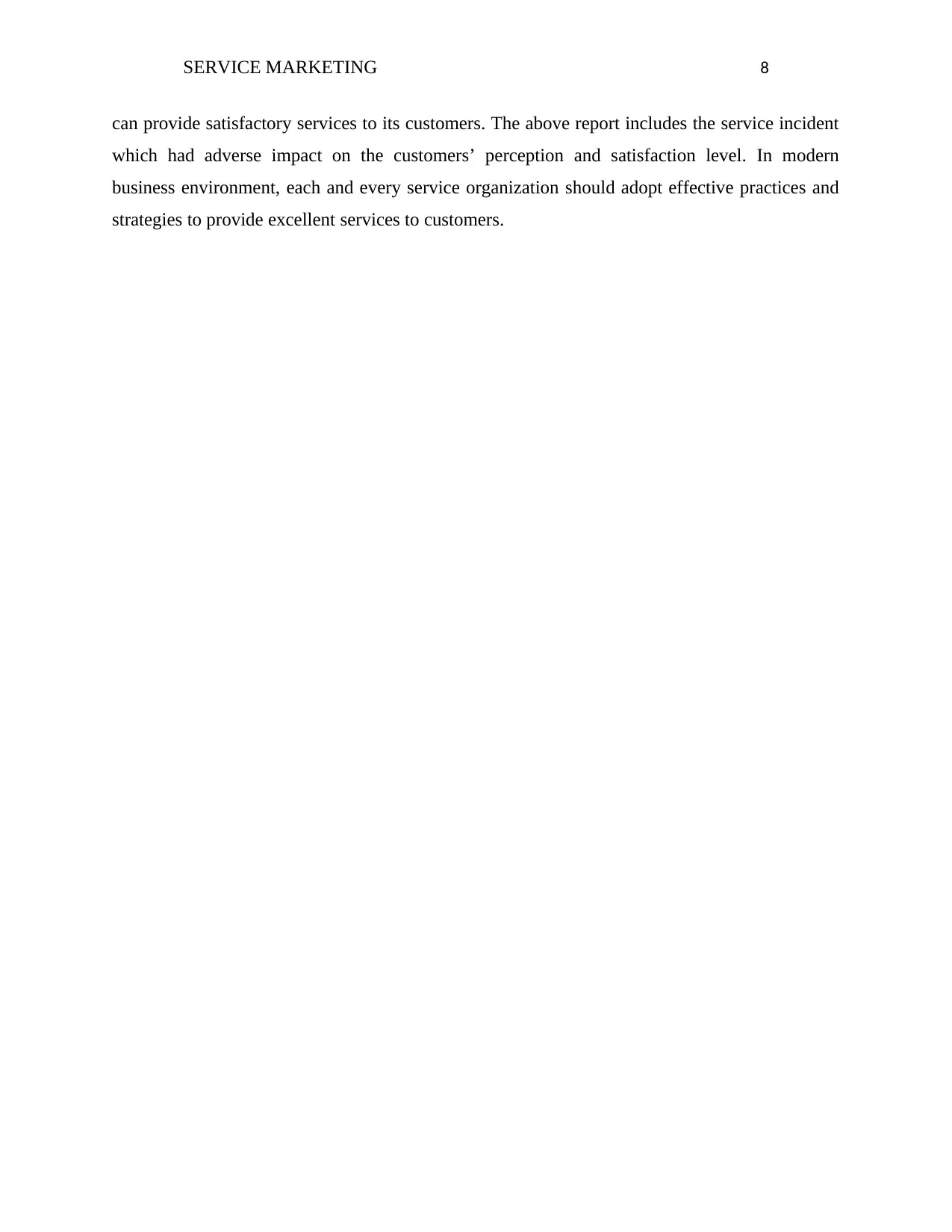
SERVICE MARKETING 8
can provide satisfactory services to its customers. The above report includes the service incident
which had adverse impact on the customers’ perception and satisfaction level. In modern
business environment, each and every service organization should adopt effective practices and
strategies to provide excellent services to customers.
can provide satisfactory services to its customers. The above report includes the service incident
which had adverse impact on the customers’ perception and satisfaction level. In modern
business environment, each and every service organization should adopt effective practices and
strategies to provide excellent services to customers.
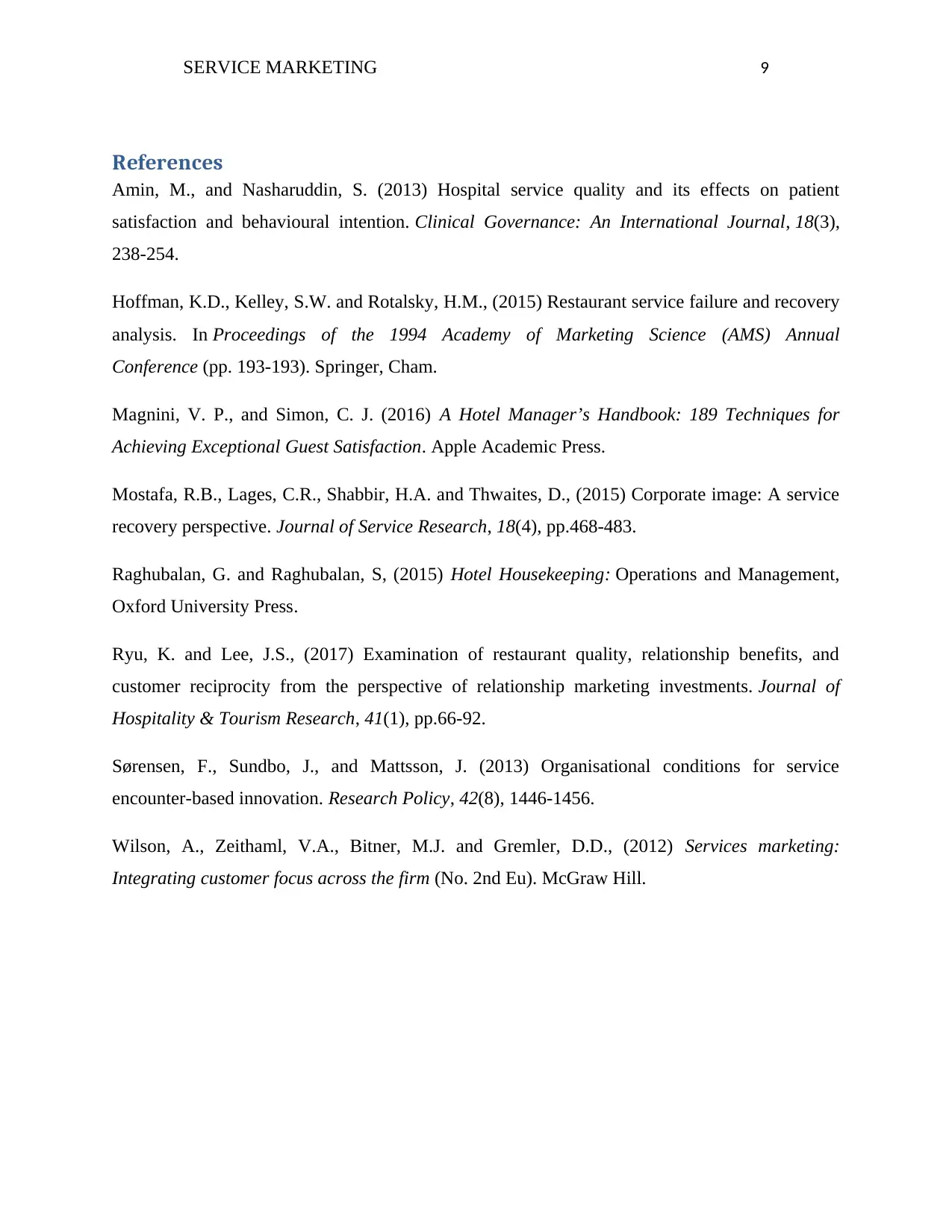
SERVICE MARKETING 9
References
Amin, M., and Nasharuddin, S. (2013) Hospital service quality and its effects on patient
satisfaction and behavioural intention. Clinical Governance: An International Journal, 18(3),
238-254.
Hoffman, K.D., Kelley, S.W. and Rotalsky, H.M., (2015) Restaurant service failure and recovery
analysis. In Proceedings of the 1994 Academy of Marketing Science (AMS) Annual
Conference (pp. 193-193). Springer, Cham.
Magnini, V. P., and Simon, C. J. (2016) A Hotel Manager’s Handbook: 189 Techniques for
Achieving Exceptional Guest Satisfaction. Apple Academic Press.
Mostafa, R.B., Lages, C.R., Shabbir, H.A. and Thwaites, D., (2015) Corporate image: A service
recovery perspective. Journal of Service Research, 18(4), pp.468-483.
Raghubalan, G. and Raghubalan, S, (2015) Hotel Housekeeping: Operations and Management,
Oxford University Press.
Ryu, K. and Lee, J.S., (2017) Examination of restaurant quality, relationship benefits, and
customer reciprocity from the perspective of relationship marketing investments. Journal of
Hospitality & Tourism Research, 41(1), pp.66-92.
Sørensen, F., Sundbo, J., and Mattsson, J. (2013) Organisational conditions for service
encounter-based innovation. Research Policy, 42(8), 1446-1456.
Wilson, A., Zeithaml, V.A., Bitner, M.J. and Gremler, D.D., (2012) Services marketing:
Integrating customer focus across the firm (No. 2nd Eu). McGraw Hill.
References
Amin, M., and Nasharuddin, S. (2013) Hospital service quality and its effects on patient
satisfaction and behavioural intention. Clinical Governance: An International Journal, 18(3),
238-254.
Hoffman, K.D., Kelley, S.W. and Rotalsky, H.M., (2015) Restaurant service failure and recovery
analysis. In Proceedings of the 1994 Academy of Marketing Science (AMS) Annual
Conference (pp. 193-193). Springer, Cham.
Magnini, V. P., and Simon, C. J. (2016) A Hotel Manager’s Handbook: 189 Techniques for
Achieving Exceptional Guest Satisfaction. Apple Academic Press.
Mostafa, R.B., Lages, C.R., Shabbir, H.A. and Thwaites, D., (2015) Corporate image: A service
recovery perspective. Journal of Service Research, 18(4), pp.468-483.
Raghubalan, G. and Raghubalan, S, (2015) Hotel Housekeeping: Operations and Management,
Oxford University Press.
Ryu, K. and Lee, J.S., (2017) Examination of restaurant quality, relationship benefits, and
customer reciprocity from the perspective of relationship marketing investments. Journal of
Hospitality & Tourism Research, 41(1), pp.66-92.
Sørensen, F., Sundbo, J., and Mattsson, J. (2013) Organisational conditions for service
encounter-based innovation. Research Policy, 42(8), 1446-1456.
Wilson, A., Zeithaml, V.A., Bitner, M.J. and Gremler, D.D., (2012) Services marketing:
Integrating customer focus across the firm (No. 2nd Eu). McGraw Hill.
⊘ This is a preview!⊘
Do you want full access?
Subscribe today to unlock all pages.

Trusted by 1+ million students worldwide
1 out of 9
Related Documents
Your All-in-One AI-Powered Toolkit for Academic Success.
+13062052269
info@desklib.com
Available 24*7 on WhatsApp / Email
![[object Object]](/_next/static/media/star-bottom.7253800d.svg)
Unlock your academic potential
Copyright © 2020–2025 A2Z Services. All Rights Reserved. Developed and managed by ZUCOL.




